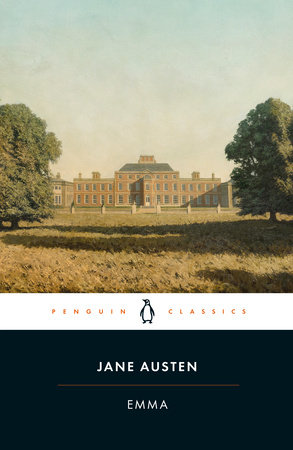Emma Reader’s Guide
By Jane Austen


INTRODUCTION
(Excerpted from The Jane Austen Book Club)
Emma was written between January 1814 and March 1815, published in 1815. The title character, Emma Woodhouse, is queen of her little community. She is lovely and wealthy. Se has no mother; her fussy, fragile father imposes no curbs on either her behavior or her self-satisfaction. Everyone else in the village is deferentially lower in social standing. Only Mr. Knightley, an old family friend, ever suggests she needs improvement.
Emma has a taste for matchmaking. When she meets pretty Harriet Smith, “the natural daughter of somebody,” Emma takes her up as both a friend and a cause. Under Emma’s direction, Harriet refuses a proposal from a local farmer, Robert Martin, so that Emma can engineer one from Mr. Elton, the vicar. Unluckily, Mr. Elton misunderstands the intrigues and believes Emma is interested in him for herself. He cannot be lowered to consider Harriet Smith.
Things are further shaken by the return to the village by Jane Fairfax, niece to the garrulous Miss Bates; and by a visit from Frank Churchill, stepson of Emma’s ex-governess. He and Jane are secretly engaged, but as no one knows this, it has no impact on the matchmaking frenzy.
The couples are eventually sorted out, if not according to Emma’s plan, at least to her satisfaction. Uninterested in marriage at the book’s beginning, she happily engages herself to Mr. Knightly before its end.
Jane Austen was born on December 16, 1775 at Steventon near Basingstoke, the seventh child of the rector of the parish. She lived with her family at Steventon until they moved to Bath when her father retired in 1801. After his death in 1805, she moved around with her mother; in 1809, they settled in Chawton, near Alton, Hampshire. Here she remained, except for a few visits to London, until in May 1817 she moved to Winchester to be near her doctor. There she died on July 18, 1817. As a girl Jane Austen wrote stories, including burlesques of popular romances. Her works were only published after much revision, four novels being published in her lifetime. These are Sense and Sensibility (1811), Pride and Prejudice (1813),Mansfield Park (1814) and Emma (1816). Two other novels, Northanger Abbey and Persuasion, were published posthumously in 1818 with a biographical notice by her brother, Henry Austen, the first formal announcement of her authorship. Persuasion was written in a race against failing health in 1815-16. She also left two earlier compositions, a short epistolary novel, Lady Susan, and an unfinished novel, The Watsons. At the time of her death, she was working on a new novel, Sanditon, a fragmentary draft of which survives.
Just for joining you’ll get personalized recommendations on your dashboard daily and features only for members.
Find Out More Join Now Sign In